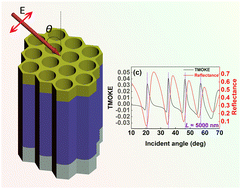Transverse magneto-optical behavior of nanoporous ferromagnetic film based on anodic aluminum oxide/aluminum template and its sensing application
Abstract
The transverse magneto-optical Kerr effect (TMOKE) has attracted widespread scientific interest because of its potential applications in biosensor technology, data storage, optical isolation, and telecommunications. More conventional architectures, including prism-based metal/magnetic multilayers and nanoarrays that integrate plasmonic and magnetic materials, are commonly used to amplify TMOKE through the high-quality propagation of the surface plasmon resonance optical mode. However, the main disadvantages of these architectures are their large ohmic losses and radiation damping, resulting in a large optical spectrum linewidth, which hinders the sensing performance. Here, we use a theoretical approach to show that it is possible to employ a low-loss Fabry–Perot optical mode on a magneto-optical platform for TMOKE signal and gaseous sensing enhancement by means of a single CoFeB ferromagnetic film directly overlayed on an already industrial anodic aluminum oxide/aluminum template. The proposed strategy can therefore potentially be exploited for high-precision and low-loss magneto-optical sensors.



 Please wait while we load your content...
Please wait while we load your content...